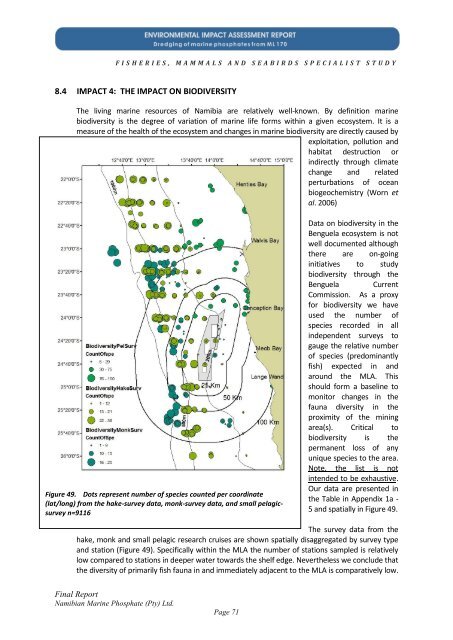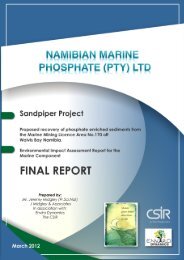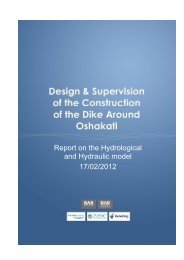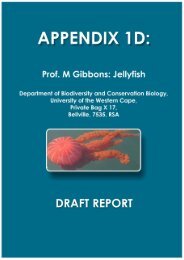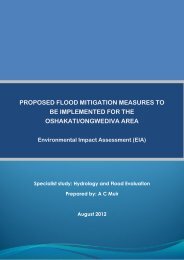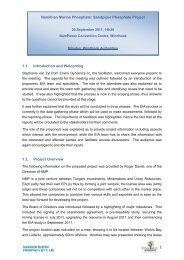Fisheries - Enviro Dynamics Namibia
Fisheries - Enviro Dynamics Namibia
Fisheries - Enviro Dynamics Namibia
Create successful ePaper yourself
Turn your PDF publications into a flip-book with our unique Google optimized e-Paper software.
F I S H E R I E S , M A M M A L S A N D S E A B I R D S S P E C I A L I S T S T U D Y<br />
8.4 IMPACT 4: THE IMPACT ON BIODIVERSITY<br />
The living marine resources of <strong>Namibia</strong> are relatively well-known. By definition marine<br />
biodiversity is the degree of variation of marine life forms within a given ecosystem. It is a<br />
measure of the health of the ecosystem and changes in marine biodiversity are directly caused by<br />
exploitation, pollution and<br />
habitat destruction or<br />
indirectly through climate<br />
change and related<br />
perturbations of ocean<br />
biogeochemistry (Worn et<br />
al. 2006)<br />
Figure 49. Dots represent number of species counted per coordinate<br />
(lat/long) from the hake-survey data, monk-survey data, and small pelagicsurvey<br />
n=9116<br />
Final Report<br />
<strong>Namibia</strong>n Marine Phosphate (Pty) Ltd.<br />
Page 71<br />
Data on biodiversity in the<br />
Benguela ecosystem is not<br />
well documented although<br />
there are on-going<br />
initiatives to study<br />
biodiversity through the<br />
Benguela Current<br />
Commission. As a proxy<br />
for biodiversity we have<br />
used the number of<br />
species recorded in all<br />
independent surveys to<br />
gauge the relative number<br />
of species (predominantly<br />
fish) expected in and<br />
around the MLA. This<br />
should form a baseline to<br />
monitor changes in the<br />
fauna diversity in the<br />
proximity of the mining<br />
area(s). Critical to<br />
biodiversity is the<br />
permanent loss of any<br />
unique species to the area.<br />
Note, the list is not<br />
intended to be exhaustive.<br />
Our data are presented in<br />
the Table in Appendix 1a -<br />
5 and spatially in Figure 49.<br />
The survey data from the<br />
hake, monk and small pelagic research cruises are shown spatially disaggregated by survey type<br />
and station (Figure 49). Specifically within the MLA the number of stations sampled is relatively<br />
low compared to stations in deeper water towards the shelf edge. Nevertheless we conclude that<br />
the diversity of primarily fish fauna in and immediately adjacent to the MLA is comparatively low.


